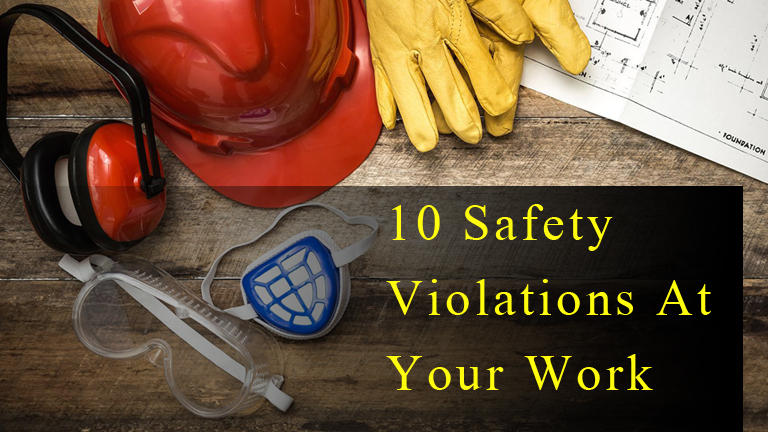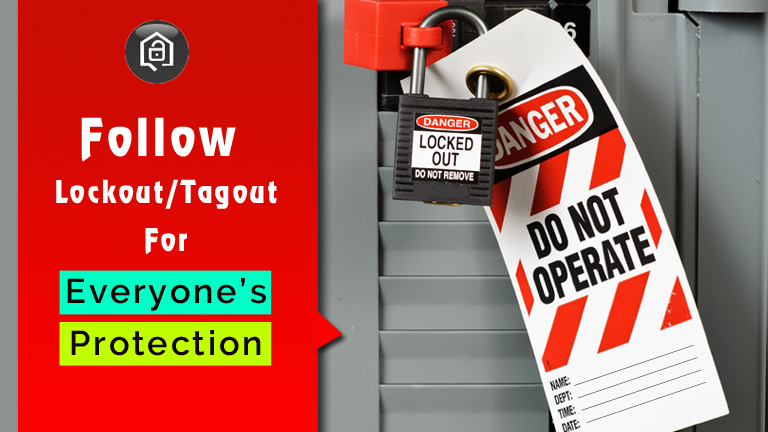
10 Safety Violations At Your Work
Posted On: January 23, 2016
Categorized In: Safety / Security
Written By: Lockout India
“What’s a workplace without safety?” All the equipments we use at home are produced by machines. With people – supervisors, workers, engineers working around these machines, the issue of ‘safety’ comes into mind. Despite warnings and cautions, every year thousands of people are injured or die due to certain violations.
Violations – Safety violations refer to those infringements that are easily avoidable by following some basic steps. These violations are measured on standards set by Occupational Safety & Health Administration (OSHA). Violations occur ‘due to negligence’ or sometimes unintentionally. manufacturer of lockout products
10 Workplace Safety Violations
1. Fall Protection
This is the most frequent violation that takes place. The workers need to be provided with standard equipments like toe boards, guard rails & safety nets that prohibit ‘falling’ from heights.
2. Hazard Communication
Workers need to be identified with the chemicals they are going to interact with. The chemical importers/manufacturers need to specify the hazards caused by the chemicals they provide through packet labels and data sheets.
3. Scaffolding
This is a construction standard violation which means accidents caused by ‘faults’. The temporary support created for construction might ‘slip’ due to weak foundation or a worker might slip. This also involves employees stuck by falling objects, faulty scaffold design – connecting hardware, load capacity and suspension rope.
4. Respiratory Protection
The workers need to wear respirators to protect themselves against insufficient oxygen supply, harmful dusts, smokes, sprays & gases. Industries produce the worst of air components. These hazards might cause cancer, breathing problems and in worst cases death.
5. Lockout/Tag out
\Machines might unexpectedly start or release stored energy like electrical, thermal, pneumatic or hydraulic during maintenance & service breaks. These are easily preventable by following the ‘OSHA safety protocols’ i.e. the LOTO safety procedure.
6. Powered Industrial Trucks
The use of heavy lifting machines like mini-cranes, forklifts, platform lift trucks, motorized hand trucks and other fuel & electricity powered trucks could cause serious injuries to workers. The breaches here are: false truck identifications, in-experienced drivers, under-age workers in the trucks, un-certified equipments etc.
7. Ladders
Industrial ladders are tall, unstable & uncomfortably placed there by posing major challenges to workers. The fall or slippage could harm the workers badly. Hence, it is the duty of managers to ensure the ladder’s efficiency.
8. Machine Guarding
Moving machine parts like saws and presses could cause lacerations & burns killing workers. Therefore, all moving machines are required to be safeguarded at all times. Managers/workers must ensure that the stoppers/guards never come off.
9. Electrical – Wiring Methods
Wiring safety is necessary for every worker. Wiring methods include installation of electrical tools in the specified and safety-insured manner. Every step of wiring process like conductors, grounding, insulation or installations should be done with adequate caution by an expert.
10. Electrical – General Requirements
It covers overall safety regulations mainly on new installations. The common defiance’s include mechanical strength, safeguards, equipment durability, connection space, electrical enclosures etc. Only a professional should follow the procedures.
Safety is a ‘serious’ issue which is why Lockout India creates products that ensure safety and follow OSHA’s safety guidelines. The safety equipments of the given violations are available at our store. Plus we have a mammoth set of safety products to ensure complete protection.
Checkout Our Other Lockout Tagout Products:
- Scaffold Tag
- MCB Lockout
- Lockout Padlocks
- Lockout Kit
Enquire Now

Lockout Procedures to Follow
Posted On: January 19, 2016
Categorized In: Lockout/Tagout
Written By: Lockout India
Lockout means shutting out machines. An industrial machine shuts for maintenance and servicing activities. It is carried out as a safety measure. The maintenance workers might injure themselves by their sudden startup. There is a certain lockout procedure implemented during the whole process. This process is undertaken by following every known guideline as given by OSHA.
As Lockout India creates safety equipment for such processes, we believe that you, our beloved readers should have an idea of the procedures followed during the process. Please note that the steps we are about to mention are general guidelines or sample steps. In reality, something very close to them is followed because admit it, “field work is much different”.
We need to understand 3 main criteria’s while learning the procedure.
- System – refers to the machines/equipment
- Authorized Employee – refers to the expert who carries out the full procedure
- Affected Employee – includes the workers, various staff members etc. who aren’t qualified to carry out the process
Lockout Procedures
Shutdown
1. The first step is to turn off all the energy sources from the operator’s panel. However, the authorized employee has to make sure that none of the affected employees are still operating as sudden power loss could lead to major accidents.
2. After power shut, notifying the affected employees is the next step. They are to leave their stations immediately and await further instructions.
3. The third step now is to shut down the whole system using normal stopping procedures like powering down, stoppers etc.
Lockout/Tag out
1. Firstly, isolate the system from any energy source. This process is called energy isolation.
2. Lockout and Tag out the system with appropriate safety products.
3. Release any stored energy from the springs, capacitors, hydraulics etc. This is very important as the residual energy in these parts could release automatically during maintenance and harm the crew.
4. Confirm that isolation has actually taken place by trying the equipment.
5. If system doesn’t start means it’s in lockdown mode.
Maintenance
Let the crew carry out maintenance and servicing.
In the meantime, continue your verifications through inspections, observations and tests.
Restarting the System
- After maintenance, remove all the locks and tags.
- Clear out all personnel and unnecessary items from the area.
- The main system shall be then restarted.
- Check whether all machines are working as they should.
- Finally, notify all the employees to resume their work.
One main thing to be kept in mind is that sometimes the work scale is too big meaning multiple authorized employees are involved. However, the procedure is more-or-less ‘the same’. It is unfortunate to say that despite several listed Lockout Tag out procedures, every year thousands of work infringements take place due to non-compliance of appropriate protocols. We, thereby urge all those who are reading this and work in the industry to go through the guidelines provided by OSHA in detail. In case you need further help regarding Lockout Tag out and safety-insured products, ping us!
Checkout Our Other Lockout Tagout Products:
- Scaffold Tag
- MCB Lockout
- Lockout Padlocks
- Lockout Kit
Enquire Now

